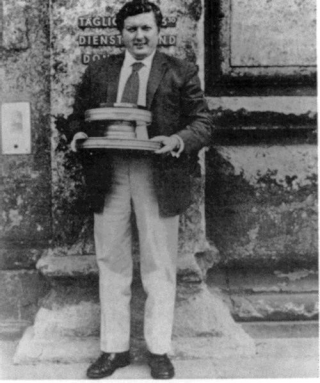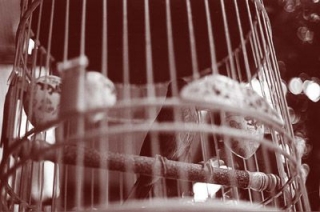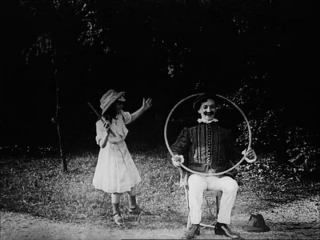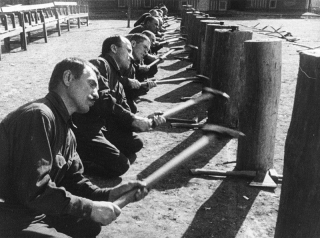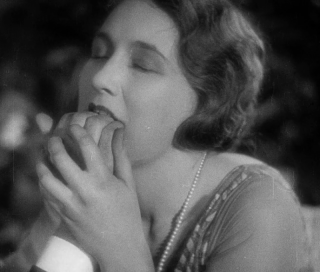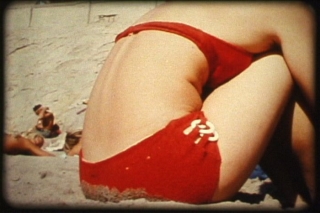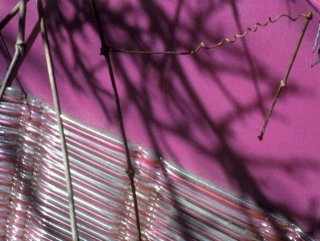Date: 8 November 2001 | Season: London Film Festival 2001 | Tags: London Film Festival, Peter Kubelka, What is Film?
PETER KUBELKA: WHAT IS FILM?
8-14 November 2001
London National Film Theatre
“Peter Kubelka is the perfectionist of the film medium” (Stan Brakhage)
A series of four public lectures in which films from Lumière to the present day will be used to celebrate cinema as a cultural phenomenon, whilst defining film as an independent medium and distinguishing it from those arts that existed before it, and the new media (such as television and the internet) that have become dominant in recent years.
Peter Kubelka will demonstrate the unique and indispensable qualities of film through detailed analysis of those works that best represent the essence of the cinema. In this extraordinary series of events, he will expose the mechanics and grammar of film that are otherwise hidden from the public. After viewing the films, the audience will have an opportunity to look over his shoulder in a situation similar to that of seeing the filmmaker at the editing table. Using a projecting Steenbeck, Kubelka will analyse, letter by letter, the language that cinema speaks. He will argue that as each mode of communication induces its own world-view, the vital and autonomous experience of cinema cannot be transferred to other media without loss of content or the understanding of the artist’s original intentions. Film is a tool that is able to create new thoughts and Peter Kubelka will bring forth the hardcore of cinema: those ideas and concepts that cannot be touched by any other art form.
“Kubelka’s cinema is like a piece of crystal, or some other object of nature: it does not look like it was produced by man.” (P. Adams Sitney)
Peter Kubelka is one of the most distinguished figures in the history of 20th century independent filmmaking. His films, made between 1955 and 1977, are an innovative demonstration of cinematic possibilities and now reside in the collections of many world-renowned museums. Moreover, his practice is not only limited to filmmaking: as an artist or theoretician he has also worked in architecture, literature, music, painting and cooking. During his time as co-director of the Austrian Film Museum in Vienna, which he founded in 1964, he has passionately dedicated himself to other artistic practices. His formation of the ensemble Spatium Musicum led to an intensive study of essential music, and his teaching on the topic of food preparation as an art form at the Frankfurt School of Fine Arts led to an extension of his title as Professor of Film to that of Film and Cooking. His design for an ideal cinema auditorium, The Invisible Cinema, has been realised in New York and Vienna. Over the past 40 years he has lectured at museums, universities and institutions throughout the world, and has been awarded the Austrian State Prize for his life’s work.
(Mark Webber)
PETER KUBELKA: WHAT IS FILM?
1: THE FILMMAKERS VIEW: THE EVENT OF CINEMA
2: THE MATERIAL OF FILM: TOOL AND PERSONALITY
3: THE LANGUAGE OF FILM: METAPHORS BETWEEN SOUNDS AND IMAGES
4: THE REAL WORLD: A MYTH CREATED BY CINEMA
Date: 8 November 2001 | Season: London Film Festival 2001 | Tags: London Film Festival, Peter Kubelka, What is Film?
PETER KUBELKA: WHAT IS FILM? 1
Thursday 8 November 2001, at 6:35pm
London National Film Theatre NFT3
THE FILMMAKERS VIEW: THE EVENT OF CINEMA
“Every endeavour to be objective is personal. I begin my analysis of cinema with the analysis of my own work, which contained my position before I was able to put some of it into words.”
Featuring the following works:
Peter Kubelka, Arnulf Rainer, Austria, 1960, 6m
Peter Kubelka, Schwechater, Austria, 1958, 1m
Peter Kubelka, Adebar, Austria, 1957, 1m
Étienne-Jules Marey, La Chronophotographie, France, 1882–1902, photographic slides
The complete list of films in the repertory, and the themes covered, may be subject to spontaneous change during the course of the presentations.
Date: 8 November 2001 | Season: London Film Festival 2001 | Tags: London Film Festival, Peter Kubelka
IN KUBELKA’S SHADOW
Thursday 8 November 2001, at 9pm
London National Film Theatre NFT3
A selection of films by former students of the “Film und Kochen” course at the Staatliche Hochschule für Bildende Künste (Städelschule) in Frankfurt. The shadow of Professor Peter Kubelka looms large over these works by his young protégés, as the films are characterised by an acute attention to detail and by the respect paid to each individual frame. Absolute care is taken with composition while cutting together adjacent shots and in the juxtaposition between sound and image. Several of the films are extraordinary travelogues, covering Romania (Palatca, Frühling 1997), Italy (Mia Zia and Il Palio) and Taiwan (Hwa-Shan-District, Taipei), as alive as the spaces they portray. Turning their attention to the body, Zehetner investigates foot fetishism, and Sackl makes a time-lapse documentation of personal activities, an elementary performance. Metropolen des Leichtsinns uses found footage to consider the possibilities of human experience. Biesendorfer’s films are the most tactile; No Wonder is a directly emotional and explicit diary of life and love.
Bernhard Schreiner, Hwa-Shan-District, Taipei, Germany, 2001, 13 min
Nino Pezzella, Mia Zia, Germany, 1992/2000, 2 x 2 min
Gergard Geiger, Palatca, Frühling 1997, Germany, 2000. 23 min
Georg Wasner, Il Palio, ein Film über die gemeinsame Reise nach Italien, Germany, 1999, 2 x 1 min
Gunther Zehetner, Meine Verehrung, Germany, 2000, 9 min
Thomas Draschan & Ulrich Wiesner, Metropolen des Leichtsinns, Germany, 2000, 12 min
Albert Sackl, Gut Ein Tag Mit Verschiedenem, Germany, 2000, 12 min
Frank Biesendorfer, No Wonder, Germany, 1999, 12 min
Many thanks to Thomas Draschan and Peter Kubelka for their assistance with this programme.
Also screening: Saturday 10 November 2001, at 1:30pm, NFT3
Date: 10 November 2001 | Season: London Film Festival 2001 | Tags: London Film Festival, Peter Kubelka, What is Film?
PETER KUBELKA: WHAT IS FILM? 2
Saturday 10 November 2001, at 4:15pm
London National Film Theatre NFT3
THE MATERIAL OF FILM: TOOL AND PERSONALITY
“Film is a transparent sculpture. The material is servant and teacher. Form cannot be transferred and therefore content cannot be transferred. The event of Cinema is unique.”
Featuring selections from the following works:
Emile Cohl, Le Cerceau Magique, France, 1908, 6m
Len Lye, Free Radicals, USA, 1958, 4m
Stan Brakhage, Mothlight, USA, 1963, 3m
Owen Land (Formerly Known As George Landow), Film in which there Appear Sprocket Holes, Edge Lettering, Dirt Particles, etc., USA, 1965-66, 5m
Karin Hörler, Frisch, Germany, 1987, 2m
Bruce Conner, Valse Triste, USA, 1979, 6m
Frères Lumière, Voltiges, France, 1898, 1m
Frères Lumière, Indochine, Enfants Anamites, France, 1898, 1m
Frères Lumière, La Course en Sacs, France, 1898, 1m
Stan Brakhage, Window Water Baby Moving, USA, 1962, 12m
Paul Sharits, T:O:U:C:H:I:N:G, USA, 1968, 12m
The complete list of films in the repertory, and the themes covered, may be subject to spontaneous change during the course of the presentations.
Date: 12 November 2001 | Season: London Film Festival 2001 | Tags: London Film Festival, Peter Kubelka, What is Film?
PETER KUBELKA: WHAT IS FILM? 3
Monday 12 November 2001, at 6:30pm
London National Film Theatre NFT3
THE LANGUAGE OF FILM: METAPHORS BETWEEN SOUNDS AND IMAGES
“Film articulates in metaphors. Between frames, between frames and contemporaneous sounds, between sounds and other sounds brought together by the maker. I will try to make the atoms of film language audible and visible.”
Featuring selections from the following works:
Fernand Léger, Ballet Mecanique, France, 1923-24, excerpt
Robert Breer, Time Flies, USA, 1997, 5m
Dziga Vertov, Enthusiasm, Russia, 1930, excerpt
Paul Sharits, Word Movie, USA, 1966, 4m
Georges Méliès, Le Magicien, France, 1898, 1m
Peter Kubelka, Unsere Afrikareise, Austria, 1966, 12.5m
The complete list of films in the repertory, and the themes covered, may be subject to spontaneous change during the course of the presentations.
Date: 12 November 2001 | Season: London Film Festival 2001 | Tags: London Film Festival
MODERN MEDITATIONS
Monday 12 November 2001, at 9pm
London National Film Theatre NFT3
Amid the constantly accelerated media milieu of the modern word, it is fortunately still possible to discover works that demand quiet contemplation, as demonstrated by this selection of predominantly abstract recent film and video. Myriam Bessette, a member of Montréal new media collective Perte-De-Signal, presents a study of the organic aspect of the electronic signal transmission. Bardo by luminary innovator Jordan Belson draws on imagery from his mesmerising and cosmic films of the past. Acting on his instruction, this new work was edited on digital video by his assistant Ying Tan and continues his life-long journey into the transcendent potential of abstraction. While contemplating the “dictatorship of meaning”, Envers provides further proof of Patrice Kirchofer’s command of photography and processing as glimpses of exquisite images briefly emerge from a body of darkness. By applying simple algorithms to visual noise, Bart Vegter created the “cellular automatons” which provide the basis of Forest-Views. The work oscillates between kaleidoscopic colour modulation and the fragile computer generated ‘chemical’ structures that pervade this remarkable film. Joel Schlemowitz offers an homage to colour, set to a poem by Wanda Phipps. Lovesong furthers Brakhage’s exposition of light. Through step-printing and painted filmstrips, he interweaves elaborate biological forms and representations. The final two films both demonstrate a visible admiration for his work; “Anodyne” is a gentle and timeless, melancholic reading, while Notre Icare creates a more contemporary, dynamic impression using music by Autechre.
Myriam Bessette, Nutation, Canada, 2000, 3 min
Jordan Belson, Bardo, USA, 2000, 20 min
Patrice Kirchhofer, Envers, France, 2001, 20 min
Bart Vegter, Forest-Views, Netherlands, 1999, 14 min
Stan Brakhage, Lovesong, USA, 2001, 7 min
Joel Schlemowitz, Morning Poem #40, USA, 2001, 2 min
Sheri Wills, Anodyne, USA, 2001, 4 min
Johanna Vaude, Notre Icare, France, 2001, 8 min
Also screening: Wednesday 14 November 2001, at 1:30pm, NFT3
Date: 14 November 2001 | Season: London Film Festival 2001 | Tags: London Film Festival, Peter Kubelka, What is Film?
PETER KUBELKA: WHAT IS FILM? 4
Wednesday 14 November 2001, at 6:30pm
London National Film Theatre NFT3
THE REAL WORLD: A MYTH CREATED BY CINEMA
“Of the world we know only what art has taught us. In the last 100 years cinema has shaped a world, real for us, of which our ancestors could not have dreamed.”
Featuring selections from the following works:
Marie Menken, Go, Go, Go!, USA, 1962-64, 11m
Robert Breer, Eyewash, USA, 1959, 3m
Michael Snow, See You Later / Au Revoir, Canada, 1990, 16m
Fernand Léger, Ballet Mecanique, France, 1923-24, excerpt
Frères Lumière, Demolition D’un Mur, France, 1896, 1m
Georges Kuchar, Hold Me While I’m Naked, USA, 1966, 15m
Georges Kuchar, Wild Night in El Reno, USA, 1977, 6m
Luis Buñuel & Salvador Dalí, L’age D’or, Spain, 1930, excerpt
The complete list of films in the repertory, and the themes covered, may be subject to spontaneous change during the course of the presentations.
Date: 16 November 2001 | Season: London Film Festival 2001 | Tags: London Film Festival
FORM AND PHENOMENA
Friday 16 November 2001, at 1:30pm
London National Film Theatre NFT3
A cinematic pageant book-ended by two new works of the visual artist Michael Snow, who was recently honoured with a retrospective at the Arnolfini Galleries in Bristol. Prelude is a parody of trailers, a metaphysical teaser about timing commissioned by the Toronto Film Festival. Ken Jacobs may be one of the most unlikely filmmakers to have ventured into digital video but Flo Rounds A Corner demonstrates a persuasive grasp of the medium. Using a system patented as ‘Eternalism’, both throbbing and molecular, Jacobs freezes and unfolds time. In his own voyage into deep cinema, Scott Stark constructs motion wonder from a set of anonymous 3D photos of a California beach. Flicker is also utilised in Clip (4000f), a mathematically edited contemplation on the death penalty. Each film by Robert Breer is a cinematic jewel, and his animated stroll through the alphabet is no exception. Using the medium in the message, Exposed toys with the voyeuristic nature of cinema, sprocket-holes masking the swelling image, while the melodrama Maria Movie is set among the grit and shards of cinemas past and present. Also using found footage, Tierney and Godovannaya bring together Jackie Chan, Margaret Thatcher and several serpents in a paean to St. Patrick. The Living Room is a sequence of baffling modulations and transformations of characters and objects, a stand-alone section from Snow’s forthcoming feature Corpus Callosum.
Michael Snow, Prelude, Canada, 2000, 3 min
Vincent Grenier, Colour Study, Canada, 2000, 4 min
Ken Jacobs, Flo Rounds A Corner, USA, 1999, 8 min
Scott Stark, Angel Beach, USA, 2001, 25 min
Robert Todd, Clip (4000f), USA, 2001, 3 min
Robert Breer, Atoz, USA, 2001, 5 min
Siegfried A. Fruhauf, Exposed, Austria, 2000, 9 min
Jeanne Liotta, Maria Movie, USA, 2001, 8 min
Moira Tierney & Masha Godovannaya, You Can’t Keep A Good Snake Down, USA/Russia, 2000, 4 min
Michael Snow, The Living Room, Canada, 2000, 21 min
Also screening: Saturday 17 November 2001, at 4:15pm, NFT3
Date: 17 November 2001 | Season: London Film Festival 2001 | Tags: London Film Festival
PERSONAL PERCEPTION
Saturday 17 November 2001, at 11pm
London National Film Theatre NFT3
The independent, privately produced film offers a valuable opportunity to explore personal viewpoints on life and the three filmmakers in this programme investigate this possibility in unique and unconventional ways. Nathaniel Dorsky comments that “the underlying motivation is the delicate reveal of the transparency of presence, our tender mystery midst the elaborate unfolding of the tree of life”. His new film Arbor Vitae is a delicate reflection on the relationships between humanity and nature. By contrast, Heinz Emigholz combines dramatic and documentary segments in a cool and controlled manner. The Miscellanea series consists of studies of art and architecture shot between 1988-97 and form part of the ongoing film cycle Photography and Beyond. The electro-acoustic composer André Almuró began to make films in his 50s and has lately developed a singular style of ‘haptic’ filmmaking in which he chronicles his personal erotic encounters. Working in 8mm, he uses pixillation, slow motion and single-framing to crystallise a unique approach to light and the body, which is accompanied by expansive electronic sound.
André Almuró, Entelechie, France, 2000, 20 min
Nathaniel Dorsky, Arbor Vitae, USA, 2000, 28 min
Heinz Emigholz, Miscellanea (I), Germany, 1998-2000, 20 min
Heinz Emigholz, Miscellanea (II), Germany, 1998-2000, 19 min
Also screening: Sunday 18 November 2001, at 12pm NFT3
